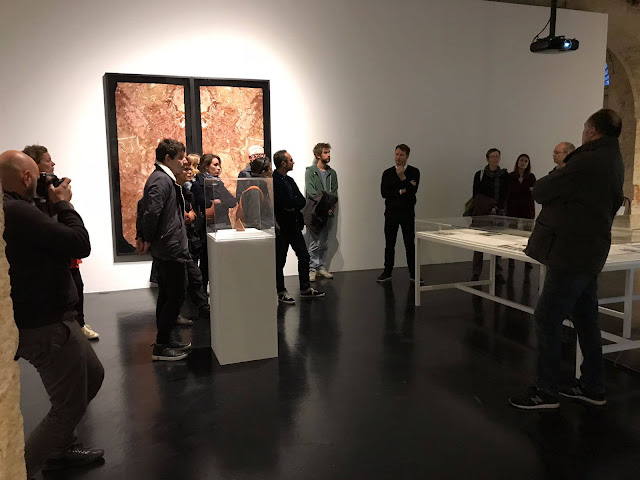Installation of Amy Balkin's ‘Today’s CO2 Spot Price’ (2009) on the opening day, 29 June 2017. Photo: Latitudes/RK.
Throughout the course of the ‘4.543 billion. The Matter of Matter’ exhibition at the CAPC musée in Bordeaux, the work by Amy Balkin (Baltimore, Maryland, 1967. Lives in San Francisco) ‘Today’s CO2 Spot Price’ (2009) charted the daily price of carbon dioxide emissions allowances in the world’s largest carbon market, the EU Emissions Trading Scheme. The numbering system was manually updated every morning to show the price in Euros of an entitlement to legally emit one metric tonne of CO2. Polluters—power plants or factories—receive or buy emissions allowances at auctions and trade them as needed to minimize costs.
A product of the increasing dominance of the finance sector and the expansion of financial derivatives that emerged in the 1970s, the carbon market ‘fix’ has abstracted the qualitative problem of climate change mitigation into a commodity market based on a molecule treated as the singular cause. There is a trend towards emissions that can be lucratively ‘avoided’, while there has been little effect on structural fossil fuel dependence. In this perspective, global warming is a market failure that can be corrected by governing the atmosphere via an economic instrument with no real material or historical reference.
Balkin's piece was presented alongside works by Pep Vidal, Lucas Ihlein, and Lara Almarcegui, all focusing on humans' calculations and quantification of nature and its progressive abstraction.
—Latitudes
(Text from the exhibition guide)
‘4.543 billion. The matter of matter’ took place between the June 29, 2017 and January 7, 2018 at the CAPC musée d'art contemporain, Bordeaux, France.

General view of room 8. Photo: Latitudes/RK.

Work by Lara Almarcegui (wall) and Pep Vidal (floor). Photo: Latitudes/RK.

Prints by Lucas Ihlein (wall) and part of a tree by Pep Vidal (floor). Photo: Latitudes/RK.
Below a sequence of all the social media posts (mostly from Instagrammers, more on this and other works on this Wakelet feed) showing the ongoing flux of its price—which has ranged from 4,84 Eur per tonne of CO2 during the installation of the piece, to 4,93 Eur on the opening day (29 June 2017), to the last picture on record showing a whopping 7,76 Eur per tonne of CO2.
We would like to thank the KADIST in San Francisco for having given us the opportunity to, after years of corresponding over email, finally meet Amy during a residency in September 2015. Her "Incidents of Travel" day on several locations in and outside San Francisco (download the specially-commissioned itinerary here) was invaluable towards the conceptualization of this exhibition.

Installing ‘Today’s CO2 Spot Price’ (2009). Photo: Latitudes for @capc

Taken on 2 July 2017. Photo: Latitudes.
Image published in the Sudouest newspaper on 12 July 2017 showing 04,98 EUR/tC02.

Taken on 13 July 2017 by Hélène Lucien.

Taken on 16 July 2017 by Adriano Pedrosa.

Taken on 2 August 2017 by Lena Joreis.

Taken on 19 August 2017 by Semi-Sans.

Taken on 22 August 2017 by Mads Freund Brunse.

Taken on 12 October 2017 by Tomas Mendizabal.

Taken on 17 October 2017 by @Margareth.

Taken on 20 November 2017 by @matlegall.

Taken on 2 November 2017 by @Elénie.

Taken on 30 November 2017 by @mllelahaye

Taken on 1 December 2017 by @mommou.elle

Taken on January 7, 2018, the last day of the exhibition, by exhibition coordinator Alice Cavender.
RELATED CONTENT:


































































